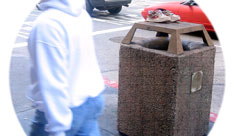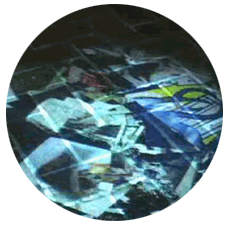|
|
|
|
|
|
|
|
|
|
|
|
||||||||
 |
|
|
||||||
|
|
||||||||
|
|
|
|
||||||
|
|
||||||||
|
|
||||||||
 |
|
|
||||||
|
|
|
|
||||||
|
|
||||||||

|

|
||||||||||||||||||||||||||||||||||||||||||||||||||||||||||
|
|
||||||||||||||
|
|
|
|
|
|
|
|
|
|
|
|
|
|
|
|
|
|
|
|
|
|
|
|
||||||||
|
OBSERVATION |
|
OBSERVATION: TRASHCAN STALKING |
|
|
|
Each Urban Probe begins with a deep, in situ, observation by body storming an activity, object, or place of interest. The first probe step, observation, is designed to deconstruct the patterns of usage, traversal, value, and meaning of urban trash. Our primary goals were to:
|
|
PROCEDURE |
|
|
|
We chose a central trashcan in downtown San Francisco, located within a
small public financial plaza near a local subway exit and adjacent to the
main downtown thoroughfare, Market Street. The trashcan sits
within a space that is neither mundane nor a picture postcard scene. While
the area contains tourists it is dominated by financial and urban workers as
well as local city dwellers. The small plaza contains “integral seating”
along a tree covered, low series of steps near the trashcan providing the
necessary elements for a convivial small urban space. It is the chosen
daily lunch and rest spot for local city workers and many of the cycle
messengers, giving it a dynamic atmosphere of everyday social activity. The
location also captures many of Lynch’s five physical factors of the city
that are integral in informing inhabitants “environmental image” giving it a
strong identity, structure and meaning. It is on the principal edge dividing
the city north and south, as well as a dominant path for automobiles, public
transport and pedestrian traffic, with wide sidewalks lined with commerce,
cafes, shops, vending stalls, and bus stops. As a culmination of these many
factors it is also inherently a strategic node for focused observation, and
navigation. The geographical and social qualities of the plaza provide a
perfect example of a dynamic, everyday city location for the study of an
urban trashcan. Using a small, fixed, concealed video camera we captured the scene immediately surrounding the trashcan. We also simultaneously logged the actions and atmosphere around the can. This included time stamped entries of the event type (items into trashcan, out of trashcan, or other), the object (description of trash) associated with the event, and the person involved with the event (gender, age, and other descriptive details observed). We also logged the approach and departure path for every individual that interacted with the trashcan in some way. This was later cross referenced to the video footage to compile a complete picture of the role that this trashcan plays in the everyday drama surrounding it. In total, three trashcan stalking exercises were performed. The first was simply a dry run with little formal data collected. The two subsequent full observations were conducted at different times. Stalking 2 was performed in the evening for nearly an hour and a half beginning at 6:30pm. The final stalking, Stalking 3, was for slightly over an hour and a half beginning at 1:15pm in the afternoon. All three stalkings were performed in the warmer summer months of rather seasonal weather in California. For example clear skies and warm (23°C) temperatures coincided with the afternoon stalking, Stalking 3. |
|
RESULTS |
|
|
|
Focusing on Stalking 3, we observed 65 individual interactions with the trashcan over the one and a half hour period. On average, the can was “used” every 80 seconds with a maximum of 6 minutes and minimum of 5 seconds between interactions. Of the 65 interactions, 47 individuals were one time users while 8 interacted more than once with the trashcan during the stalking. Even within this highly focused view of a single urban trashcan, the data was highly revealing and vivid. We were able to extract many insights into the interrelationship between people, place, actions and trash. Plotting the paths taken by the people that interacted with the trashcan revealed that many of them stayed in the immediate area for several minutes or more, either before or after using the can – a total of 54% across both observations, 34% of the 18 interactions in Stalking 2 and 60% of the 65 interactions in Stalking 3. Informal interviews in the plaza supported the conclusion that a high proportion of people who use this trashcan spend a considerable amount of time in the plaza as part of their daily routine. Regular interactions with the trashcan included trash going in, scavengers searching within it, scavenged items being remove, bikes being parked and collected from the trashcan (an impromptu bike stand), and the trashcan being cleaned or emptied. Surprising less than 75% of the trashcan interactions involved actually discarding trash. Over a quarter (33% in Stalking 2 and 27% in Stalking 3) of the trashcan’s use was composed of other interactions such as searching in, removing from, and cleaning the trashcan. The trashcan was also revealed as a point of exchange. Items of value such as food, recyclables, and re-usable objects such as shoes were removed within minutes of being thrown away. Interestingly, scavengers that searched for food never took recycling and vice versa. On occasion a single bottle of Sprite soda was first observed being dropped vertically into the can, almost full, only minutes later to be picked out, finished and thrown back. The bottle resurfaced only a few minutes later in the same stalking as it was collected for recycling by a third individual. Similar patterns of exchange were observed by Whyte who conducted a short study of trashcans in Manhattan in the 1970s. In this study Whyte commented that such regular trashcan scavenging actually provided regular upkeep by compressing trash and hence preventing garbage overflow. San Francisco’s exceptional recycling rate (63%) is supported in a small degree by those that sort through city trashcans. As with the city workers on lunch time breaks, scavengers were also regular visitors to the plaza. We observed scavengers often walking cyclical routes that took them back to the same can more than once. The contents of the trashcan were rarely surprising, a vast majority of items were food related, primarily the packaging from nearby cafés, coffee stands and fast food restaurants. Other common items included newspapers, magazines, cigarette butts, boxes, and plastic bags. It’s important to note that the seemingly large volume of trash collected in public containers accounts for only a small percentage of the total trash of a city. By far the largest portion of urban trash is composed of domestic and construction waste which were intentionally excluded from our study. The lack of unusual items reflects both common habits and the business of the plaza as opposed to the type of trash found in other separately located trashcans. Our conclusion for this step of
the Urban Probe is that the type and amount of trash deposited into a
public trashcan reveals a story of the local ebb and flow of the space,
chronicles the daily rhythms of a place and time, and hints at the
identity and presence of city inhabitants. This insight is full of
qualitative stories, like observing young men repeatedly using a
trashcan for target practice or the tools and techniques used to fish
recycling from within the can. It suggests both a wider picture of place
and social ecology. It paints as intriguing stories of authentic life
within the mass of the city – stories inspired by curiosity and drawn
out by imagination. |
|
Several 8 minute intervals of activities and pattern flows surrounding our stalked trashcan |
|
Urban Atmospheres at Intel Research |